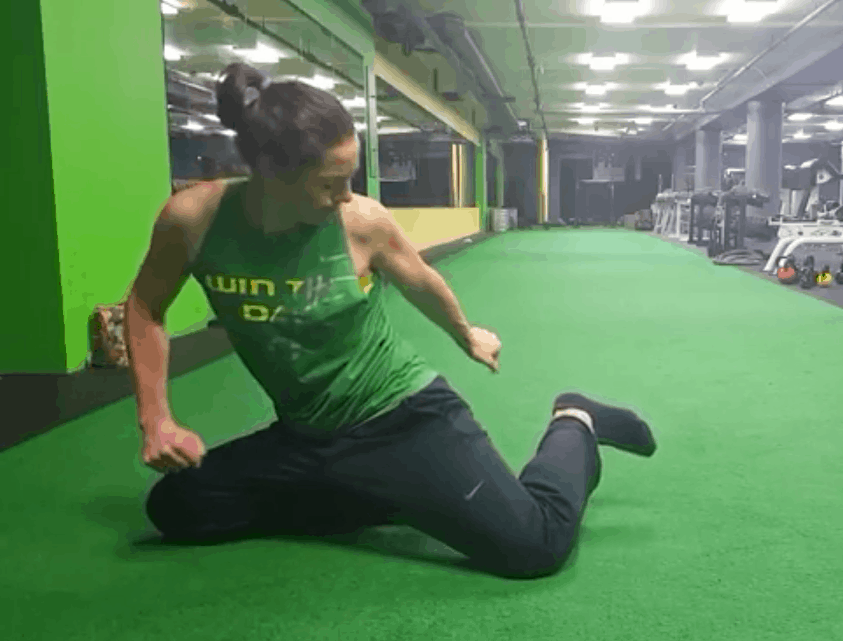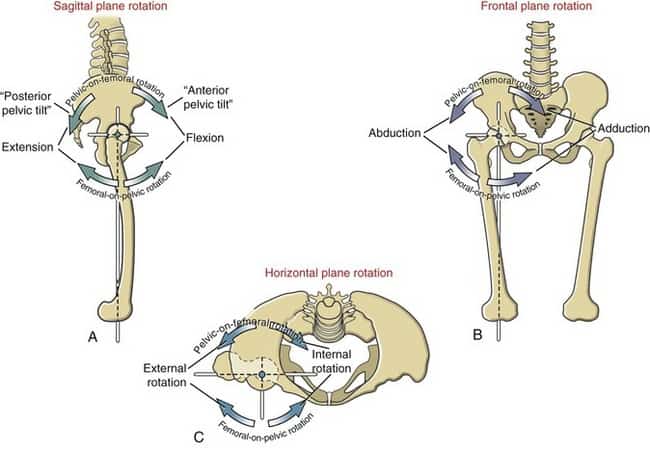
Hip Internal Rotation – Manipulating Joints Above and Below
Pelvic motion and knee flexion influence hip rotation.
Structures above and below a joint have a direct impact on the way it functions. For the hip, its surrounding articulations are the knee and the pelvis. Stiffness or motion in either affects what the hip is able to do. The truth in what you believe is happening is dependent upon the context in which the information lies. Regarding the hip, a flexed knee and a stiffened pelvis can make the possible seem impossible. Manipulate these variables and you can find a suitable challenge to match every need.
In a previous post on hip internal rotation, straight-legged regressions were presented and explained. An extended knee treats the leg as one long lever. The upper and lower halves work in unison, along the same line. A flexed knee creates two separate levers which weigh upon each other. An L-shaped lever creates more torque, which is why the 90/90 position can cause havoc on those unprepared to utilize it.
The pelvis that houses the hip socket is also capable of motion. It can tilt, twist, flex, extend, and rotate all on its own. Coming across this article by Dr. Steven Osterer set off more than a few light bulbs. The pelvis can rotate on the femur just as the femur can rotate on the pelvis. This means pelvic motion can mimic hip motion. What we train and celebrate as hip rotation, then, might actually be coming from the pelvis.
To distinguish between the two, Samantha Faulhaber created this excellent short that shows visual contrast between hip isolation and integration with the pelvis:
Note how the non-rotating leg stays relatively still in part one. The right hip can move independent of the left hip. In part two, the bent leg moves without the butt/ hip. The ability to separate movement from neighboring joints is a test of autonomous function.
As much as we want to make individual joints ‘work nice’, joint coupling has its advantages.
First, efficient motion is naturally interdependent. Second, for large patterns to be broken down into smaller patterns, whittling gives a more holistic picture than hacking. Narrowing a ten joint movement to five, and then two, establishes a broader perspective on the interconnectedness of parts. Third, and perhaps the most important benefit of using one joint to assist another, is compliance. A person new to a system will not do something that pinches or hurts them, no matter how well you can explain what’s happening and why. Pointing out and letting people use ‘cheats’ take them from incapable to capable in an instant. If you can adjust movement to make them successful and pain-free, they’ll likely stick around longer to hear what else you have to say.
The hip sleeper serves as an excellent entry level hip movement because of its simplicity and ease of access. A stuck knee can often drop a bit lower if it is driven forward by the pelvis and lumbar spine:
Similarly, lengthening the non-rotating leg lessens any competing tension and gives the moving side a few more degrees of freedom:
Once the knee reaches the desired target, re-flexing the support leg achieves the intended goal and the body learns what is necessary to accomplish the task.
Should awareness lead you back to investigate individual joint integrity, practice from the prone position can help you single out hip movement from pelvic movement. The key is to minimize any gaps between the upper thigh and the floor. Since the pelvis is ‘resting’ on the ground, any lift offs or tunnels near the groin area indicate pelvic torsion instead of socketed hip rotation:
Just like a lateral lean when standing, torso angles are modified to meet increased hip demands. A flexed knee lying face down becomes assistive – a shorter lever and space to monitor and control.
Keep in mind that positioning in one leg affects the abilities of the other. Knee flexion and external rotation in the ‘off’ leg make it more difficult to maintain the floor-hugging internal rotation of the up leg:
Getting something, and then attempting to keep it (termed #getitkeepit) is a demonstration of progressive challenges that build upon each other in real time. They can start as ‘cheats’ or supports that are slowly taken away or difficult placements that must adapt to changing conditions. The following is a sample of continued rigor, play, creation, and learning:
TO REVIEW:
- Rotation is a sign of joint health and ability.
- The hip is affected by the joints that flank it, the pelvis and the knee.
- A long leg with extended knee acts as a single lever, and rotation is a communal effort
- A flexed knee produces shorter levers that can act in resistance to one another
- Pelvic rotation can facilitate and disguise itself as hip rotation
- Not all cheats are meant to be hacks; they can be a constructive component to a process
- Prone hip internal rotation can highlight pelvic influence through thigh gaps
- “Get it, keep it” is a means of building functional competence and variability





thank you, thank you, thank you! I always wondered why I couldn’t do certain yoga poses or pole moves – almost no internal rotation is the cause, and now I can do something about it! 🙂
Yes! Thanks for the note. So happy to help.
This made such a difference for me.
Honestly, the 90/90 position can be explored for hours…only to find out there is more to discover.
Used it myself upon waking, then with a patient at work. Boom, opened that internal rotation.
Success!